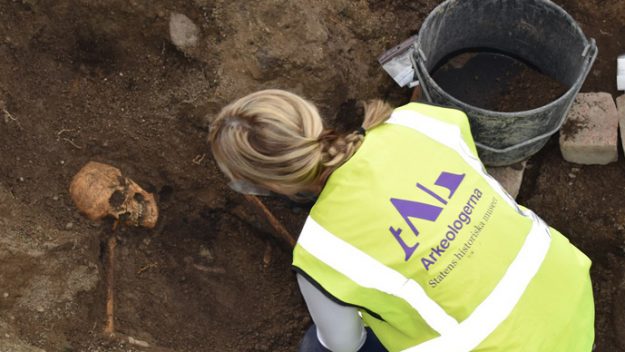Thanks for visiting our blog! As a thank-you, enjoy 15% off your first order in our online Viking Shop with the discount code BLOG15.
Archaeologists announced July 4, 2019, that they have found the remains of two Viking-era ship burials in Uppsala, Sweden. Along with earlier Norwegian finds in Østfold County (October 2018) and Vestfold County (March 2019), four Viking Age ship burials have been found in Scandinavia within the last year.
Archaeologists and Viking enthusiasts are thrilled because these findings are rare and potentially offer tremendous amounts of new information on life and death in the Viking Age. Only 10 ship graves have ever been found in Sweden, with the last one being 50 years ago. Even fewer have been found in Norway.
Both of the ship graves found in Norway were discovered using ground-penetrating radar. This cutting edge technology and techniques were developed by Austria’s Ludwig Boltzmann Institute for Archaeological Prospection and Virtual Archaeology. Together with aerial photography, Light Detection and Ranging (LIDAR) technology, and other new advances, ground-penetrating radar is making it possible for archaeologists to make more discoveries much more efficiently and less invasively than ever before. However, once the archaeologists know where to start their dig, the large amount of funding, time, and labor can still be prohibitive, and so at the time of this writing excavation has not yet begun on the two new Norway ship graves.
The latest find of the two ship graves in Sweden was discovered the old-fashioned way – entirely by accident. A local church in the village of Gamla Uppsala was building an addition to its old vicarage house when the ships were uncovered. One of the vessels had already received a lot of damage, perhaps when the basement of the vicarage was initially constructed.
Whether through scattering, natural decay, or even ancient grave-robbing, neither bones nor grave goods have yet been found for that ship grave. This is unfortunate, as it appears to have been the larger ship and therefore probably would have had more impressive artifacts buried with the higher status individual interred there. Still, there are iron and wood pieces of the ship itself that offer valuable information for study.

The second ship grave, however, is described as in “pristine” condition, with the skeleton of a man (lain in the stern of the ship) along with the bones of his dog and his horse. There were iron fittings (presumably from the horse’s saddle, bridle, and other tack). There was also a spear, a sword, a shield, and an ornately-carved comb. Ancient peoples the world-over often buried their dead with such “grave goods,” though whether these valuables were meant to literally follow their owners into the afterlife or were just a sign of respect varied over time and place. The Norse poems Sigurtharkvitha en skamma (A Short Poem of Sigurth) and Helrith Brynhildar (Bynhild’s Ride to Hel), found in the Poetic Edda, both mention heroes carrying into the afterlife possessions they were buried with and being accompanied by the animals or even people sacrificed at their funerals.
At the time of our last reports, none of the four ship graves have been officially dated yet. However, we know from previous finds that ship burials like these come from the Viking Age (793-1066) or the Vendel period before it (roughly 550-800).

One of the reasons finds like these have been so rare is that only very high-status individuals could be buried this way. Ships were precious and took a lot of resources and skill to produce, so to put one in the ground and then raise a large mound of earth over it showed the care and respect of an entire community. Some Viking funerals involved burning the ship on the water (as famously described by the 10th-century Arab explorer Ahmad ibn Fadlan, and often depicted in film). This, of course, creates a near-impossible target for the archaeologist. For most people at this time, cremation on a pyre with a few possessions would have been the norm. Interestingly, archaeologists map the cultural change of the late Viking Age by using the transitions from these various diverse funerary practices to regularized Christian burials.
The new Uppsala site and artifacts are currently being studied by teams of researchers. Soon some of the artifacts are to be displayed at the Gamla Uppsala Museum and the Swedish History Museum at Stockholm.
SonsOfVikings.com is an online Viking jewelry and merchandise store that is also the author of the Viking history book entitled Sons of Vikings, as well as a provider of many free articles such as Viking symbolism, Viking runes, Viking history and more.
Photo Credits: Arkeologerna, Shm
References
- Georgiou, A. Viking Burial Ships Uncovered in “Sensational” Archeological Find. Newsweek. July 4, 2019. https://www.newsweek.com/archaeologists-rare-burial-ships-sensational-find-1447622?fbclid=IwAR12FKPlwroeMZohhVYpoA2PiNJVAkQDdEDjaJjkxjLYQfDdlrXjdByA8OY
- Valera, S. Two Rare Viking Burial Ships Unearthed in Sweden. Geek.com July 4, 2019. https://www.geek.com/news/two-rare-viking-burial-ships-unearthed-in-sweden-1794531/?fbclid=IwAR2AQBAa474o3Gw5fp_Ul-nfj7sW8Gbuci72G4QGCaBSEFHJQX57qq0rHM0
- Valera, S. Geo-Radar Detects Viking Ship Buried Underground in Norway. Geek.com. March 25, 2019.
- Kennedy, M. Viking Ship Burial Discovered in Norway Just 50cm Underground. The Guardian. October 15, 2018. https://www.theguardian.com/science/2018/oct/15/viking-ship-burial-discovered-in-norway-just-50cm-underground
- Horton, M. & Heyd, V. Six Tools That Are Revolutionizing Archaeology by Helping Us Find Sites Without Digging. The Conversation. December 7, 2015. https://theconversation.com/six-tools-that-are-revolutionising-archaeology-by-helping-us-find-sites-without-digging-51826
- A Viking Burial Described by Arab Writer Ahmad ibn Fadlan. Thor News. May 12, 2012. https://thornews.com/2012/05/12/a-viking-burial-described-by-arab-writer-ahmad-ibn-fadlan/
- Crawford, J. (Translator/Editor). The Poetic Edda: Stories of the Norse Gods and Heroes. Hacket Publishing, Indianapolis. 2015.

